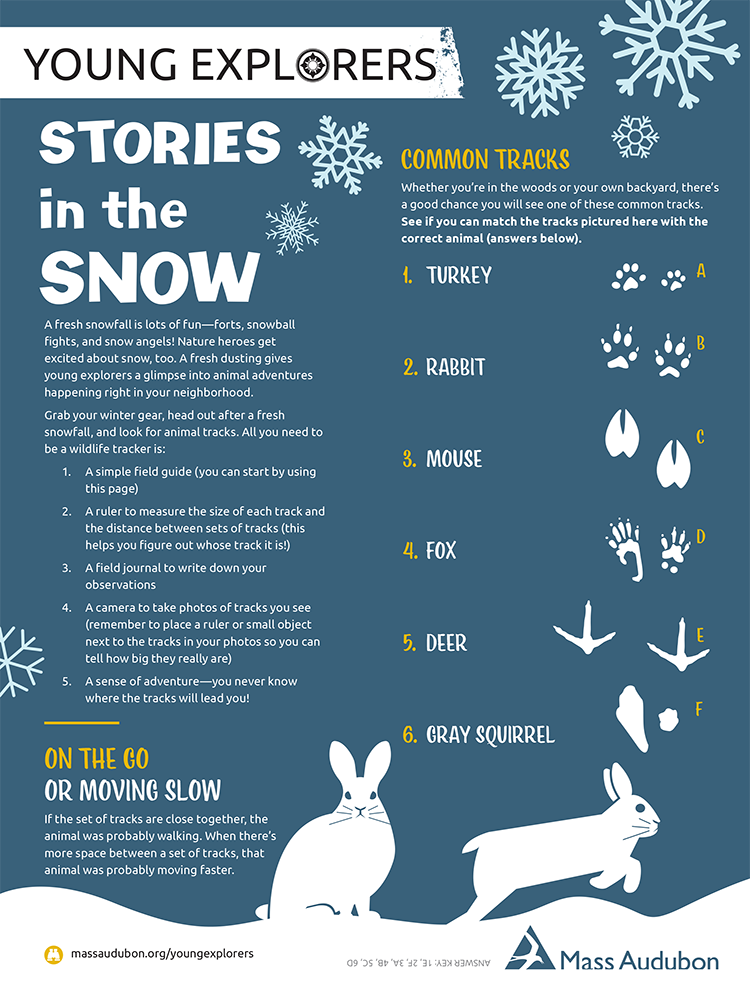Stories in the Snow Activity Page
From Explore, Winter 2020
Download & Print
Web Exclusive
Learn how to identify common track patterns and characteristics. With enough information, you just might be able to "read" the story of the tracks you find!
Tracking in the Field
Trackers look for track patterns and characteristics. See if you can collect some of this field data on any tracks you find. With this data, and the use of a field guide, you can identify most animal tracks!
Types of Track Patterns
If the tracks match one of these four patterns, that can help you determine what animal left the tracks.
Hoppers (mice, chipmunks, rabbits, & squirrels)
These animals do a leap-frogging movement, so their front feet land first and then their back feet land in front of their front feet.
Zig-Zaggers (deer, fox, coyote, moose, & bobcat)
Also called “perfect walkers,” these animals walk carefully to conserve energy. Their rear paw/hoof will land exactly where their front paw previously fell.
Waddlers (beaver, woodchuck, skunk, raccoon, muskrat, & bear)
These animals move one side of their body and then the other side when they walk. Their rear foot does not land where the front foot landed, so their tracks have four "waddle-like" prints.
Bounders (otters, weasels, minks, & fishers)
Otters—and other animals in the weasel family—place their front feet down and leap! Their rear feet land in the exact spot where the front feet went, leaving two side-by-side tracks.
Track Characteristics
Observing, measuring, and recording any of this field data can help you identify tracks.
- How big are the tracks? Is there a difference in size between the front and back feet?
- How many toes are there and what shape are they? Is there any webbing between the toes? Does the animal have nails or claws?
- How long is the stride? "Stride" is the distance between two tracks on the same side, measured from the heel of one track to the heel of the other track.
- How wide is the straddle? "Straddle" is how far apart the tracks are, measured from the outside of the right track to the outside of the left one.
- How deep is the track?
Track Stories
Tracks usually tell a story. Can you figure out what happened in these examples?
Description of Tracks Found | What May Have Happened |
| Single line of fox tracks | A fox walked here recently, perhaps searching for a meal or returning to its den |
| Mouse tracks with tail imprint showing | A White-footed Mouse scurried about, looking for food or escaping from a hungry predator |
| Crisscrosses of four-legged tracks and a pile of chewed nut shells | A red squirrel looked for (and found!) some of its stored nuts |
| Grey squirrel tracks ending at the base of a tree | The squirrel probably went up the tree |
| A bunch of turkey tracks | A flock of turkeys trotted by recently |
| Rabbit tracks ending abruptly where they meet large wing imprints; a mat of fur is visible | A rabbit was hunted by an owl or hawk (depending on how the wing prints are shown) |
Stay Connected
Don’t miss a beat on all the ways you can get outdoors, celebrate nature, and get involved.




